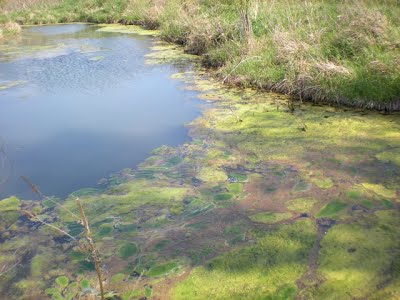This lesson was developed by Heidi Mehl Introduction- Presentation to StudentsWhen we talk about nutrients in the water, we are referring mainly to nitrogen and phosphorus. Nitrogen and phosphorus are found naturally in small amounts in healthy streams. Aquatic plants and animals have to have small amounts of these nutrients to live and grow, just as you need vitamins, calcium, and other important substances from your food in order to live a healthy life. Nutrients can enter rivers and lakes from many different sources. Sometimes, these sources can contribute too many nutrients, which can be “too much of a good thing.” Remember, aquatic plants and animals need small amounts of these nutrients to survive. Large amounts, however, can cause harmful effects and actually kill plants, fish, and other aquatic species. Let’s talk first about where these nutrients come from. There are two different types of pollution – point source and non-point source pollution. Point source pollution comes from a pipe or other narrow, isolated spot. If you can point to one place where pollution is entering a stream or river, it is a point source. Non-point sources are large, broad areas that pollute when rain washes over them and the water runs off into the water. It is not possible to pinpoint one place where the pollution is entering the stream – instead it comes from a wide area. Most nutrient pollution in Kansas comes from non-point sources. One major problem is crops that use fertilizer. We grow a lot of corn, soybeans, and other crops in Kansas. Many farmers use fertilizer containing nitrogen to help the plants grow bigger and faster. Fertilizer is spread on the fields in springtime, at the same time that we get a lot of heavy rain. When the rain washes over the fields, it carries a lot of this fertilizer and nitrogen into rivers and lakes. Another major problem is cattle and other livestock. We have a lot of cows and other animals in Kansas that are raised for meat and milk. These animals produce a lot of manure, which also contains nitrogen and phosphorus (this is why manure is often used for fertilizer). Manure gets washed into rivers and lakes during heavy rains, contributing even more nutrients (as well as bacteria). Too many nutrients can have very harmful effects on aquatic life. You have probably seen a common result of nutrient pollution – algal blooms. Have you ever seen a pond that is bright green with globs of slimy-looking goo floating on the surface? That pond has too many nutrients, and the green “goo” is actually algae. All plants need nutrients, but algae have the ability to use excess nutrients to grow and multiply more rapidly than other plants. Algae use the extra nutrients to fuel a population explosion. This is harmful to other plants and animals, because the algae use up all of the oxygen in the water as they die and decompose. Without oxygen, fish and other aquatic plants will die. Too much nitrogen is also very harmful to fish, as it can cause their blood to stop carrying oxygen. The consequences of nutrient pollution can also affect you. It can make our recreational areas unusable - who wants to swim or boat in water covered with thick green gooey algae? If it is happening in water that is used for drinking water, it might cost more money to remove the algae and excess nutrients before it can be used for drinking water. There can still be a bad taste or odor that shows up in your drinking water. There are things that you and your family can do to help reduce nutrient pollution. Growing our food is a very important job, and there are management practices the farmers can use to continue growing lots of healthy food while reducing nutrient pollution in our streams and rivers. See if there are programs in your area that encourage farmers to plant trees between their fields and rivers or streams. Trees and grasses can help filter some of these nutrients before they reach the water. They can also apply fertilizer in small amounts over a number of weeks, instead of all at once. Friends of the Kaw is currently working with farmers to begin using some of these practices in our area. |
What's in the Water? >




